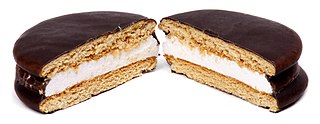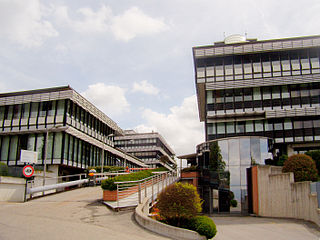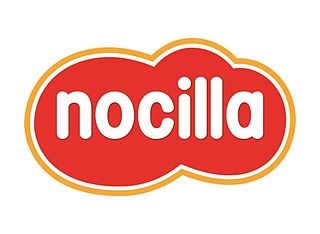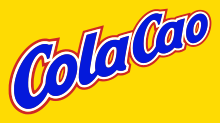History
In 1945, José María Ventura and José Ignacio Ferrero, two brothers-in-law from the Gràcia neighborhood of Barcelona, Spain, created a soluble cocoa called Cola Cao. [5]
In 1962, they began to broadcast their first advertisements on television, which adapted the radio tune to some cartoons. In 1972, Cola Cao was associated for the first time with the slogan "Olympic food", after becoming a sponsor of the Spanish Olympic team at the 1972 Summer Olympic Games. In the 1980s, "Cola Cao VIT" was produced, an instant and enriched version with vitamins of the classic Cola Cao. It went out of production in the late 1980s.
In 1988, in a connection with the 1992 Summer Olympics scheduled for Barcelona Cola Cao began sponsoring the Spanish Olympic Committee through the ADO Program, an alliance that continues until today. Along the same lines and to promote urban sports, the brand installed what are popularly known as "Cola Cao Circuits" in green areas of a large number of Spanish cities, such as Esplugues de Llobregat and Córdoba, among others. In the mid-nineties, with the slogan the same flavor of Cola Cao with half the calories, a version of Cola Cao without sugar and with sweeteners called "Cola Cao Low in Calories" was launched, which in the mid-2000s was renamed "Cola Cao Light".
Online Controversy and Coverage
The companies Nesquik and Cola Cao have been closely compared to each other online. However on March 31, 2016 a parody Cola Cao Twitter page sparked an argument with a parody Spanish Twitter page. Cola Cao said about how they "have a song" but questioned what Nesquik has instead, "a talking rabbit". The Nesquik account later swore and commented on the signature bits. [16] This resulted in the official pages of the two brands along with companies like Nestlé clarifying the correct and verified company pages. [17]
The OCU [ es ], a member organization of Euroconsumers, compared the two brands to help to close the arguments online directed at which brand is better. [18] They compared the cocoa contents and added fibers of the two brands and the OCU concluded that, although other companies provided higher quality chocolate sources, Cola Cao placed 4th: higher than Nesquik. [19] People on Twitter and Facebook argue about which is better and try to bring everyday evidence to suggest that one company has a new product which makes it better than the other; and this has quickly spread onto the local news. For example, on July 6, 2020 McDonald's released the Cola Cao McFlurry [20] which people have used as arguments against Nesquik, [21] questioning if the company has this or not. [22]

Chocolate or cocoa is a food made from roasted and ground cacao seed kernels that is available as a liquid, solid, or paste, either on its own or as a flavoring agent in other foods. Cacao has been consumed in some form for at least 5,300 years starting with the Mayo-Chinchipe culture in what is present-day Ecuador and later Mesoamerican civilizations also consumed chocolate beverages before being introduced to Europe in the 16th century.

Cola is a carbonated soft drink flavored with vanilla, cinnamon, citrus oils, and other flavorings. Cola became popular worldwide after the American pharmacist John Stith Pemberton invented Coca-Cola, a trademarked brand, in 1886, which was imitated by other manufacturers. Most colas originally contained caffeine from the kola nut, leading to the drink's name, though other sources of caffeine are generally used in modern formulations. The Pemberton cola drink also contained a coca plant extract. His non-alcoholic recipe was inspired by the coca wine of pharmacist Angelo Mariani, created in 1863.

Nutella is a brand of brown, sweetened hazelnut cocoa spread. Nutella is manufactured by the Italian company Ferrero and was introduced in 1964, although its first iteration dates to 1963.

Nestlé S.A. is a Swiss multinational food and drink processing conglomerate corporation headquartered in Vevey, Switzerland. It has been the largest publicly held food company in the world, measured by revenue and other metrics, since 2014. It ranked No. 64 on the Fortune Global 500 in 2017. In 2023, the company was ranked 50th in the Forbes Global 2000.

A Moon Pie is an American snack, popular across much of the United States, which consists of two round Graham crackers, with marshmallow filling in the center, dipped in a flavored coating. The snack is often associated with the cuisine of the American South, where they are traditionally accompanied by an RC Cola. Today, MoonPies are made by Chattanooga Bakery, Inc., in Chattanooga, Tennessee.

Ovaltine is a brand of milk flavoring product made with malt extract, sugar, and whey. Some flavors also have cocoa. Ovaltine, a registered trademark of Associated British Foods, is made by Wander AG, a subsidiary of Twinings, which acquired the brand from Novartis in 2002, except in the United States, where Nestlé acquired the rights separately from Novartis in the late 2000s.

Ferrero International SpA, more commonly known as Ferrero Group or simply Ferrero, is an Italian multinational company with headquarters in Alba. Ferrero is a manufacturer of branded chocolate and confectionery products, and the second biggest chocolate producer and confectionery company in the world. Ferrero SpA is a private company owned by the Ferrero family and has been described as "one of the world's most secretive firms". Reputation Institute's 2009 survey ranked Ferrero as the most reputable company in the world.

Powerade is a sports drink created and sold by the Coca-Cola Company. Its primary competitor is Gatorade, owned by PepsiCo.

Milo is a chocolate-flavoured malted powder product produced by Nestlé, typically mixed with milk, hot water, or both, to produce a beverage. It was originally developed in Australia by Thomas Mayne (1901–1995) in 1934.

Chocolate syrup is a sweet, chocolate-flavored condiment. It is often used as a topping or dessert sauce for various desserts, such as ice cream, or mixed with milk to make chocolate milk or blended with milk and ice cream to make a chocolate milkshake. Chocolate syrup is sold in a variety of consistencies, ranging from a thin liquid that can be drizzled from a bottle to a thick sauce that needs to be spooned onto the dessert item.
Energy Brands, also doing business as Glacéau, is a privately owned subsidiary of The Coca-Cola Company based in Whitestone, Queens, New York, that manufactures and distributes various lines of drinks marketed as enhanced water. Founded in May 1996 by J. Darius Bikoff with an electrolyte enhanced line of water called Smartwater, Energy Brands initially distributed its products to health food stores and independent retailers in the New York area. Adding Fruitwater and Vitaminwater to its line in 1998 and 2000, respectively, the company expanded to nationwide distribution in the early 2000s.

Swerve was a flavored and vitamin-fortified dairy drink introduced in the United States in 2003 by The Coca-Cola Company. It contained 51% skim milk, was sweetened by a blend of sugar and sucralose, and provided 30% of the recommended daily allowance of Vitamins A, C & D and Calcium. It was available in three flavors: a vanilla-banana flavor called Vanana, a blueberry-strawberry flavor called Blooo, and a chocolate flavor. It was most often found in school cafeterias.

Nocilla is a Spanish brand of hazelnut and chocolate spread similar to Nutella. It is sold in Spain and Portugal, was first launched in the late 1960s, and after its acquisition from Unilever in 2002 has been manufactured by Nutrexpa.

Monster Beverage Corporation is an American beverage company that manufactures energy drinks including Monster Energy, Relentless and Burn. The company was originally founded as Hansen's in 1935 in Southern California, originally selling juice products. The company renamed itself as Monster Beverage in 2012.
Barry Callebaut AG is a Swiss-Belgian cocoa processor and chocolate manufacturer, with an average annual production of 2.3 million tonnes of cocoa & chocolate . It was created in 1996 through the merging of the French company Cacao Barry and the Belgian chocolate producer Callebaut. It is currently based in Zürich, Switzerland, and operates in over 30 countries worldwide. It was created in its present form by Klaus Johann Jacobs.

Nesquik, also known as Nestlé Nesquik and Nesquik Cereal, is a family of breakfast cereals made by Cereal Partners Worldwide in a joint venture between of the American company General Mills and the Swiss company Nestlé, and based on the popular Nesquik product line.

Nesquik is a brand of food products made by Swiss company Nestlé. In 1948, Nestlé launched a drink mix for chocolate-flavored milk called Nestlé Quik in the United States; this was released in Europe during the 1950s as Nesquik.

Idilia Foods is a Spanish food business group. The company is headquartered in Barcelona and was established in 1940. It produces food items such as fish stock cubes, baker's yeast, caramel or honey.


















